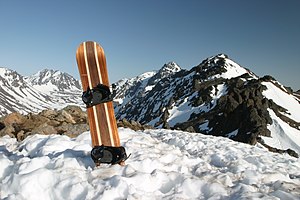Local Forecast Center Chugach National Forest Avalanche Information Center and Alaska Avalanche School Gearing Up This Weekend
November is Avalanche Awareness Education month in Alaska, and with a large weather system reaching Southcentral Alaska today, both the region's forecast center, Chugach National Forest Avalanche Information Center (CNFAIC), and the Alaska Avalanche school are finalizing preparations for the year ahead.
 |
| Peak Three, near Anchorage, Alaska (Photo credit: Wikipedia) |
"We've seen a major increase in backcountry users in the Chugach National Forest during recent years," said Wendy Wagner, avalanche forecaster with the CNFAIC. "Starting today, we will be issuing daily avalanche advisories which will continue through April."
This resource is available to the public online at www.cnfaic.org, providing information for backcountry travelers in two heavily traveled areas on the Kenai Peninsula, chiefly Turnagain Pass.
Reviewing an avalanche advisory before venturing into avalanche terrain is the smart thing to do, and it is a practice taught to each student who takes courses at the Alaska Avalanche School.
"We want our students to be prepared to make the best possible decisions in the field," said Aleph Johnston-Bloom, Executive Director of the Alaska Avalanche School. "Fortunately we've got some great resources in our area, like the Chugach National Forest Avalanche Information Center."
Despite the late arrival of snow, interest in avalanche education has been high this fall. December courses offered by the Alaska Avalanche School are nearly full, with new students registering daily. Courses begin in two weeks.
Weekend Media Opportunities:
CNFAIC forecasters will be at the Glacier Ranger District in Girdwood and out in the field in the Turnagain Pass area this weekend assessing snow and avalanche conditions. To set up an interview, call Wendy Wagner at 435-640-6508.
The Alaska Avalanche School is conducting it's instructor training this weekend. Interviews/filming opportunities are available throughout the day on Saturday in Anchorage, when course curriculum will be reviewed in a classroom setting.
On Sunday, media is invited during select times when the school's field training session takes place at Hatchers Pass. For more information, or to set up a time, contact AAS Executive Director Aleph Johnston-Bloom at 907-345-0878.
About The Center/School:
The Chugach National Forest Avalanche Center is a public safety service housed under the U.S. Forest Service whose mission is to increase avalanche awareness in the Turnagain area though advisories and public education.
Alaska Avalanche School is a 501c3 organization with a mission to provide exceptional experienced-based snow and avalanche education to all users of the mountain environment. The school has been around over 35 years, recently teaching 1200 students per season.
For more Information:
Wendy Wagner, Avalanche Forecaster, Chugach National Forest Avalanche Center 435-640-6508 or wendy@chugachavalanch.org
Aleph Johnston-Bloom, Executive Director, Alaska Avalanche School 907-345-0878 or alaskaavalanche@mac.com
Wendy Wagner
Chugach National Forest Avalanche Information Center
www.cnfaic.org
Chugach National Forest Avalanche Information Center
www.cnfaic.org
wendy@chugachavalanche.org
(435) 640-6508
(435) 640-6508
PO Box 129
Girdwood, AK 99587
Girdwood, AK 99587




